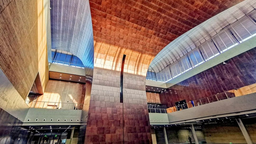Resurrection of the lost art
On the Buddha Ceremony Stage in the Longmen Grottoes Scenic Area in Luoyang, Central China's Henan province, "Emperor Xiaowen" of the Northern Wei Dynasty (386-534) and "Queen Wenzhao" walked slowly with a group of maidservants following them.
The ceremony exudes awe-inspiring dignity with the royal family burning incense and practicing their Buddhist devotions. The live performance-presented by the staff at the historic site on April 25-invited viewers to travel back to 1500 years ago and project into and inhabit the historic scene portrayed in Emperor and Empress' Ceremony to the Buddha, a duo set of grotto artworks that used to be on the walls of the Binyang Middle Cave of Longmen Grottoes.
When saluting, the royals bow their dignified heads to the feet of the Buddha, confess with sincerest hearts, and make good vows with all piety.
The Binyang Middle Cave of Longmen Grottoes, a royal cave excavated during the Northern Wei Dynasty, is of great importance, as these life-size figures are presented extremely balanced in a picture-story book composition.
"It is a national treasure with great historical and cultural value," says Gao Dan, a researcher at Longmen Grottoes Research Institute. In the 1930s, the sculptures were stolen, damaged, sold, and smuggled overseas. "We hope to 'resurrect' the ceremony by various means, and such live performance is one of our many restoration plans, and painstaking efforts have been made by our staff after nearly three months of preparation."
In order to restore the scene more vividly and realistically on the stage, researchers and the main creative team of the Longmen Grottoes Research Institute collected a variety of related documents and pictures, and drilled down to deeper levels of detail. They studied every figure from their makeup, clothing, props and movements.
The Northern Wei Dynasty was established by the Xianbei, an ancient nomadic people that once resided in the eastern Eurasian steppes in what is today Mongolia, Inner Mongolia and northeastern China. "After Emperor Xiaowen implemented the reform of assimilation to the Han ethnic culture, especially the Han clothing etiquette, the emperor wore a mianliu, king's crown with tassels, and gunfu, a ceremonial dress for Han royalty that features wide robes, large sleeve and long-lined gown.
"The powerful forms of the dressing create an impression of regal majesty," says Gao.
The team also referred to historical documents in the selection of actors. Except for the emperor and queen, most of the 40 actors and actresses are under 20 years old. "According to documental records, Emperor Xiaowen died at the age of 33, and the trace of time had not yet crawled up to his young face by the look of the sculpture, and his concubine and entourage would be younger," says Zhu Guoqing, director of the live performance.
"As early as more than a month ago, the actors and actresses began to learn, imitate and understand the expressions, gait and psychological activities of the characters in the sculpture, and then they were assigned roles according to their appearances. After many rehearsals and a little bit of correction in their expression, we now have the final show right on."
Emperor and Empress' Ceremony to the Buddha, in two parts namely Emperor Xiaowen's Ceremony to the Buddha and Empress Wenzhao's Ceremony to the Buddha, was carved on each side of Binyang Middle Cave, showcasing the development of ancient painting concepts and sculpture art.
They are of important value for the study of ancient Chinese painting, sculpture, social history, clothing, religion and multiethnic integration. "Through the live performance, virtual displays, film and television promotion, traditional art can be presented in a modern way, which helps the public to understand the excellent Chinese traditional culture," says Gao.

From left: The actresses take selfies while trying on costumes before they hit the stage for the live performance on April 25; the actresses are being filmed in the studio; the actresses present the viewers behind the scene tidbits from the shooting of the episode after their makeup is done. LI AN/XINHUA
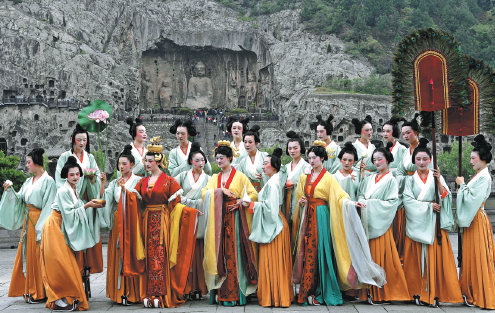
The actresses relive the scene from the classic grotto artwork Emperor and Empress' Ceremony to the Buddha in the Longmen Grottoes Scenic Area in Luoyang, Central China's Henan province. LI AN/XINHUA
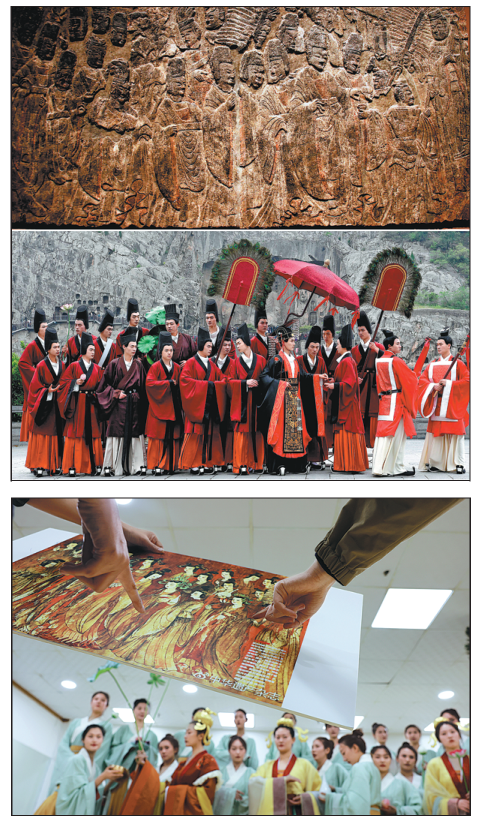
Top: Emperor Xiaowen's Ceremony to the Buddha is currently in the Metropolitan Museum of Art in New York. The picture is provided by the Longmen Grottoes Research Institute. Middle and above: Reenactment scenes of the artwork by actors and actresses from the institute. LI AN/XINHUA
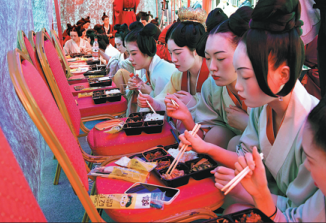
The actresses have lunch between performances. LI AN/XINHUA
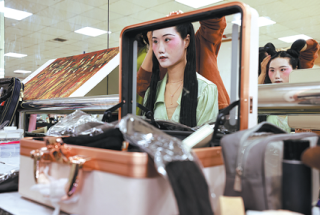
The actresses put on their makeup in the rehearsal hall. LI AN/XINHUA
